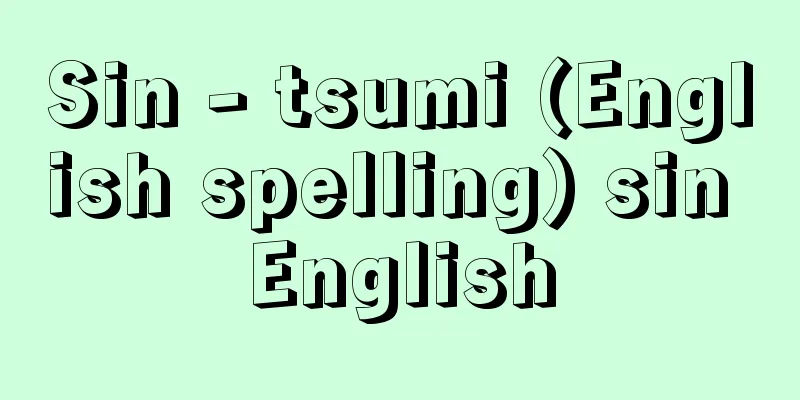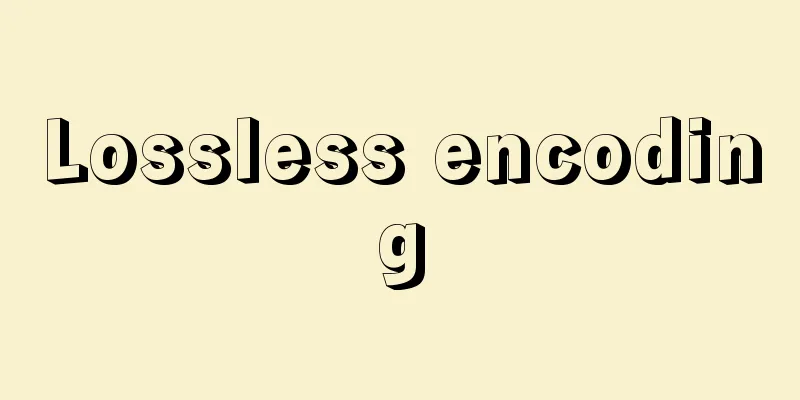Sin - tsumi (English spelling) sin English

|
Broadly speaking, any act that goes against legal, moral, or religious norms is called "sin," but religious acts of rebellion in particular are sometimes called "sin" to distinguish them from legal crimes. When used as a translation of the English word "sin," it is primarily used in the religious sense. In primitive societies, breaking taboos was considered a sin, and in such cases the social, moral, and religious concepts of sin were undifferentiated and mixed together. [Shigeru Matsumoto] Sin and Impurity in Ancient JapanOriginally, the Japanese word "tsumi" was a contraction of "tsutsumi" and derived from the verb "tsutsumu." "Tsutsumu" means that there is something bad in anything, and the archaic words "tsutsumu kotonashi" and "tsutsuminashi" (nothing bad) and "tsutsushimu" are all derived from this. Therefore, in ancient Japan, not only moral wrongdoings, but also illness and other disasters, impurities, ugliness, and anything else that people in the world hate and detest were all considered "tsumi." It is significant that the central reference point there is not the will of a specific god, but the overall will of the human community. In the "Oharae no Kotoba" in the "Engishiki," sins are broadly divided into "Amatsutsumi" and "Kunitsumi." The Amatsuzai are: ahanachi (leaving banks), mizoume (filling in ditches), hihanachi (leaving gutters), shikimaki (sowing too much), kushizashi (impaling), ikihagi (stripping something alive), sakahagi (stripping something upside down), and kusobe (excavating a toilet), and according to myth, they are prototypes of the crimes committed by Susanoo-no-Mikoto in Takamagahara, but they mainly consist of acts that disrupt the order of agricultural communities. In contrast, the Kunitsuzai are the crimes of cutting off the living skin, cutting off the dead skin, white people, black people, crime against one's mother, crime against one's child, crime against mother and child, crime against child and mother, crime against livestock, misfortunes caused by insects, misfortunes caused by Takatsukami, misfortunes caused by Takatsutori, killing livestock, and committing wicked things. In addition to killing, injuring, and incest, natural disasters, physical ugliness, and curses are all listed in the same category as these crimes. As the word "tsumikegare" indicates, all of these crimes were considered to be the same as impurity. And as a ritual to purify oneself from this impurity, misogiharae (purification rituals) have an important meaning. Moreover, sin and impurity are not considered to be evil deeply rooted in human nature, but something that can be purified by the power of purification. In this respect, it is fundamentally different from the ideas of original sin and earthly desires (bonno). [Shigeru Matsumoto] Sin in Ancient SocietiesIn ancient Japan and other ancient societies, there was generally no clear distinction between legal, moral, and religious sins, and political and religious authorities controlled all of them. In ancient China, sin was the subject of "divine punishment," and the punishment given by the monarch (Son of Heaven) was meant as a proxy for divine punishment. As the religious nature of Heaven became weaker in later times, sin lost its original religious meaning and came to simply mean "breaking the law." In the early religious traditions of ancient Israel, which became the mother of Christianity and Islam, religion and politics were also undifferentiated. However, in Israel, faith in a transcendent one God was central, and in this connection sin originally meant disobedience and rebellion against God. The story of Adam's fall in the Book of Genesis is a good symbol of this. [Shigeru Matsumoto] Sin in ReligionIn Christianity, sin is considered to be a problem that is deeply related to the inner self of human beings. In other words, since Adam sinned, humans have been under the condition of sin and death, and humans can be freed from this not by faithfully observing the law, but by faith in Jesus Christ, who died and rose again to atone for human sins. In this case, the law is considered to have the purpose of making humans aware of their sins. As the church developed, a distinction was made between "mortal sins" and "venial sins." Mortal sins were idolatry, murder, adultery, etc., and those who committed them were excommunicated from the church and were punished forever in hell. Venial sins can be forgiven by confessing and performing acts of atonement. Roman Catholicism has traditionally maintained this distinction, but Protestants do not accept it and take the general position that acts and attitudes of rebellion against God are sins. In Buddhism, sins are broadly divided into "sexual sins" and "obstructive sins." Sexual sins are inherently evil no matter who commits them, and examples include killing, stealing, committing sexual acts, and lying. Killing one's parents or an arhat is particularly serious, and is counted among the five grave sins known as the "Five Cardinal Sins," along with harming the Buddha's body and disrupting the harmony of the Sangha (disintegrating and disrupting the religious community). In Mahayana Buddhism, slandering the True Dharma (slandering Buddhism) is sometimes added to these to make the five cardinal sins. The term "banzai" refers to actions that are not inherently sinful but are contrary to what is prohibited by the precepts. For example, drinking alcohol. In Pure Land Buddhism, which developed later, the idea of sin was recognized as an internal problem deeply rooted in human nature. In other words, human existence was understood as being "deeply sinful and full of worldly desires," and salvation through the power of Amida Buddha's original vow (other power) was desired and believed in. [Shigeru Matsumoto] GuiltIn terms of religious psychology, the sense of guilt (feeling of guilt) arises already in infancy (around 4 or 5 years after birth) with the formation of what Freud called the "superego" (conscience). According to Erikson, in psychoanalysis, the sense of guilt is the feeling that one has imagined committing an act that not only was not actually committed, but was in fact impossible to carry out. [Shigeru Matsumoto] "Orikuchi Shinobu Complete Works 1: Ancient Studies" (1954, Chuokoron-Shinsha) ▽ "Kishimoto Hideo (ed.), "World Religions" (1965, Daimeido) Source: Shogakukan Encyclopedia Nipponica About Encyclopedia Nipponica Information | Legend |
|
広くは法律的、道徳的、または宗教的な規範に反した行為すべてをさすが、とくに宗教的な意味での背反行為を、法律上の犯罪などから区別して「罪」ということがある。英語のsinの訳語として用いられるときには、主として宗教的な意味である。原始社会ではタブー(禁忌)を犯すことが罪とされたが、その場合には社会的、道徳的、宗教的な罪観念が未分化で、混然一体としている。 [松本 滋] 日本古代の罪と穢れもともと日本語では「つみ」という語は、「つつみ」のつづまった形で、「つつむ」という動詞に由来する。何事にせよ悪いことがあるのを「つつむ」といい、古語の「つつむことなし」「つつみなし」(悪いことなし)とか「つつしむ」などは、いずれもそこから派生したものである。したがって日本古代においては、道徳的悪行のみでなく、病をはじめとするもろもろの災いや穢(けが)れたこと、醜いこと、その他何でも世の中の人が憎み嫌うことはすべて「つみ」とされた。そこでは特定の神の意志ではなく、人間の共同体の全体的意向が中心的準拠点になっていることは、意味が深い。『延喜式(えんぎしき)』の「大祓詞(おおはらえのことば)」では罪を「天津罪(あまつつみ)」と「国津(くにつ)罪」とに大別している。天津罪は畔放(あはなち)、溝埋(みぞうめ)、樋放(ひはなち)、頻蒔(しきまき)、串刺(くしざし)、生剥(いきはぎ)、逆(さか)剥、屎戸(くそべ)で、神話によれば須佐之男命(すさのおのみこと)が高天原(たかまがはら)で犯した罪がその原型とされているが、主として農業共同体の秩序を乱すような行為からなっている。これに対して、国津罪は生膚断(いきはだだち)、死膚(しにはだ)断、白人(しろひと)、胡久美(こくみ)、己母犯罪(おのがははおかせるつみ)、己子(おのがこ)犯罪、母与子(ははとこと)犯罪、子与母(ことははと)犯罪、畜(けもの)犯罪、昆虫(はうむし)の災(わざわい)、高津神(たかつかみ)の災、高津鳥(たかつとり)の災、畜仆(けものたお)し、虫物為(まじものせる)罪で、殺生(せっしょう)、傷害、近親相姦(そうかん)などのほか、自然の災禍や肉体上の醜さ、呪咀(じゅそ)行為までが罪として同列に数え上げられている。「つみけがれ」という語に示されているように、これらの罪はいずれも穢れと同一視された。そしてその穢れから清まるための儀礼として、禊祓(みそぎはらえ)が重要な意味をもつ。また罪穢れは人間性に深く根ざした悪ではなく、祓えの力によって祓い清めうるものと考えられた。その点、原罪や煩悩(ぼんのう)の観念と本質的に異なっている。 [松本 滋] 古代社会における罪日本古代に限らず、古代社会においては、一般に法律的、道徳的、宗教的な罪の間に明確な分化がなく、政治・宗教的権威がそのすべてを統御していた。中国古代では、罪は「天罰」の対象であり、また君主(天子)の下す刑罰は、天罰の代行としての意味をもっていた。後代になって天の宗教性が希薄になるにつれて、罪はその本来の宗教的意義を失い、単に「法を犯すこと」を意味するようになった。キリスト教やイスラム教の母胎となった古代イスラエルの宗教伝統においても、初期においては宗教と政治は未分化であった。ただイスラエルにおいては超越的な唯一神への信仰が中心的であり、それに関連して罪は本来的に神に対する不服従、反逆という意味をもっていた。「創世記」に描かれたアダムの堕落の物語がそれをよく象徴している。 [松本 滋] 宗教における罪キリスト教においては、罪は人間の内面に深くかかわる問題としてとらえられている。すなわち、アダムが罪を犯して以来、人間は罪と死のもとにあり、人間がそれから解放されるのは、律法を忠実に守り行うことによってではなく、人間の罪を贖(あがな)って死に、そしてよみがえったイエス・キリストを信ずる信仰によってであるという。その場合、律法は人間に罪の自覚を生ぜしめる意味をもつものとされた。教会の発展に伴い、「大罪」と「小罪」の区別が行われた。大罪は偶像崇拝、殺人、姦通(かんつう)などで、これを犯した者は教会から破門され、永遠に地獄の罰を受けるものとされた。小罪は懺悔(ざんげ)し、罪を贖う行為をなすことによって、赦(ゆる)しを受けることができるものである。ローマ・カトリックは伝統的にこの区別を保持してきたが、プロテスタントはこれを認めず、ただ神に反逆する行為・態度を罪とする一般的立場をとっている。 仏教においては、罪は「性罪(しょうざい)」と「遮罪(しゃざい)」とに大別される。性罪はどういう立場の人が行っても本質的に罪悪であることで、たとえば殺生、偸盗(ちゅうとう)、邪婬(じゃいん)、妄語(もうご)などがそれにあたる。殺生のなかでも父母や阿羅漢(あらかん)に対するそれはとくに重く、出仏身血(仏の身体を傷つけること)および破和合僧(教団を分裂攪乱(かくらん)させること)と並んで、「五逆」とよばれる重罪に数えられる。大乗仏教では、これらに誹謗正法(ひぼうしょうぼう)(仏法をそしること)を加えて五逆という場合もある。 遮罪というのは、本来的に罪悪ではないが、戒律で禁止されていることに背反した行為をさす。たとえば飲酒(おんじゅ)などがそれである。のちに展開した浄土仏教においては、罪悪の観念は人間性に深く根ざした内面的問題として意識された。すなわち人間存在は、「罪悪深重(じんじゅう)、煩悩熾盛(しじょう)」なるものとして把握され、阿弥陀仏(あみだぶつ)の本願の力(他力)による救済が渇望、信仰された。 [松本 滋] 罪の意識宗教心理学的には、罪の意識(罪悪感)はすでに幼児期(生後4、5年ごろ)にフロイトのいう「超自我」(良心)の形成とともに生じてくる。エリクソンによれば、罪の意識とは、精神分析的には、実際に犯さなかったばかりか、事実上実行不可能な行為を、想像のうえで自分が犯してしまったと感じる意識だという。 [松本 滋] 『『折口信夫全集1 古代研究』(1954・中央公論社)』▽『岸本英夫編『世界の宗教』(1965・大明堂)』 出典 小学館 日本大百科全書(ニッポニカ)日本大百科全書(ニッポニカ)について 情報 | 凡例 |
<<: Stone mound - Tsumiishizuka
>>: Tsumi (Japanese lesser sparrow hawk)
Recommend
Winter bird
…These birds also migrate south in autumn. The fo...
Kawane [town] - Kawane
A former town in Haibara County in the middle reac...
Boxer, CR (English)
...Historian James Murdoch (1856-1921), writer L....
Allende meteorite - Allende meteorite
A meteorite that fell in Allende, Mexico (Chihuahu...
Woodsworth, James Shaver
Born: July 29, 1874, Toronto [Died] March 21, 1942...
Amida-ga-mine
It is one of the 36 peaks of Higashiyama in the ea...
Cutting edge construction
One of the steps in making a Japanese sword. Ridge...
Great Dane (English spelling)
A domestic dog originating from Germany. A descend...
Industrial Association - Sangyokumiai
A cooperative organization based on the Industria...
University of Cologne - University of Cologne
It is one of the medieval universities founded in...
Feldjäger (English spelling)
…From then on, the gendarmerie took on the duties...
Schrettinger, M.
...A discipline that combines theory and practice...
Otakara Kou - Otakara Kou
A perennial plant of the Asteraceae family (APG c...
Agus Salim
1884‐1954 A representative politician and thinker ...
Colored streamlines - Colored streamlines
…In a flow that varies over time, the images capt...









